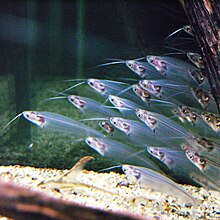Glass Catfish
- "Glass catfish" in the aquarium trade refers usually to the Ghost Catfish, K. minor (see below). It can also mean any of the Asian glass catfishes (Kryptopterus) or the African glass catfishes (Parailia).
| Glass Catfish | |
|---|---|
 | |
| Scientific classification | |
| Domain: | Eukaryota |
| Kingdom: | Animalia |
| Phylum: | Chordata |
| Subphylum: | Vertebrata |
| Superclass: | Osteichthyes |
| Class: | Actinopterygii |
| Subclass: | Neopterygii |
| Infraclass: | Teleostei |
| Superorder: | Ostariophysi |
| Order: | Siluriformes |
| Family: | Siluridae |
| Genus: | Kryptopterus |
| Species: | K. bicirrhis |
| Binomial name | |
| Kryptopterus bicirrhis (Valenciennes, 1840) | |
The Glass Catfish (Kryptopterus bicirrhis) is an Asian glass catfish of the genus Kryptopterus. Until 1989, it included its smaller relative the Ghost Catfish, now known as K. minor. Its scientific name and common name are often still used in the aquarium fish trade to refer to the Ghost Catfish; as it seems, the larger and more aggressive K. bicirrhis was only ever exported in insignificant numbers, if at all.[1]
In western Borneo, where they are sympatric, both K. minor and K. bicirrhis are collectively known as lais tipis in the Malay language, but when locals want to distinguish the two, they refer to the Glass Catfish as lais limpok. In Cambodia, where it is known as trey kes prak, the Khmer people use the Ghost Catfish as a key ingredient in the fine fish condiment prahoc.[2]
Description
The main difference to K. minor is the longer anal fin of the Glass Catfish, which in the latter has more than 54 and up to 68 rays. The present species also grows much larger – 15 cm (5.9 in) standard length, or twice the size of its relative; specimens measuring as much as 24.5 cm (9.6 in) standard length are reputed to exist. Its head is also lighter on average.[2][1]
Like the Ghost Catfish, K. bicirrhis is transparent except for the head, bones, and the internal organs which are located directly behind the head. When struck by light, they show an iridescence, and when dead, they turn milky white. They have two long barbels, which are as long again as the body in front of the anal fin. The dorsal fin is reduced to a tiny triangle, and the pectoral fins are longer than the head.[2][1]
Ecology
While the Ghost Catfish is sympatric with the Glass Catfish in western Borneo (Indonesia), the present species' range is much larger. Apart from the whole of Borneo, it also includes Sumatra, the Malay Peninsula, as well as the Chao Phraya and Mekong drainage basins.[2]
These freshwater catfish inhabit large rivers with turbid water, where they typically seem to live near the shore in regions with pronounced currents. Peaty water with a rather low temperature (for its tropical range) of 21 to 26 °C (70 to 79 °F) seems to be preferred. They are diurnal predators which mainly eat true water bugs (Nepomorpha) and occasionally smaller fishes.[2]
See also
| Wikimedia Commons has media related to: Kryptopterus minor |
References
- ^ a b c "Kryptopterus bicirrhis". Planet Catfish. April 6, 2008. http://www.planetcatfish.com/catelog/species.php?species_id=1758. Retrieved April 7, 2010.
- ^ a b c d e Torres, Armi G; et al (February 11, 2010). "Kryptopterus bicirrhis". FishBase. http://www.fishbase.us/Summary/speciesSummary.php?ID=10920. Retrieved April 7, 2010.
Free Template Blogger collection template Hot Deals BERITA_wongANteng SEO theproperty-developer

0 comments:
Post a Comment